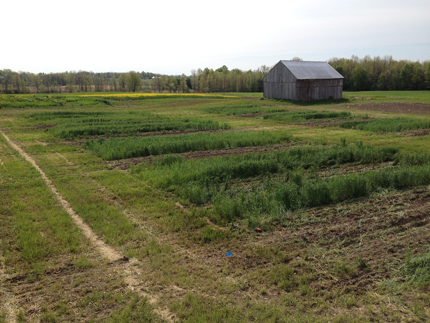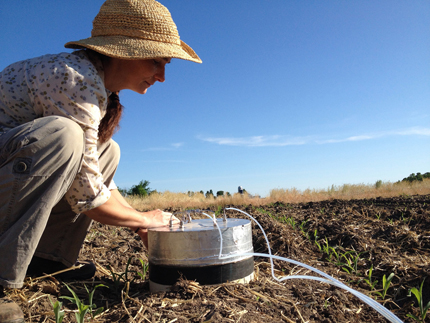Soil Science Society of America
5585 Guilford Road • Madison, WI 53711-5801 • 608-273-8080 • Fax 608-273-2021
www.soils.org
Twitter | Facebook
NEWS RELEASE
Contact: Hanna Jeske, Associate Director of Marketing and Brand Strategy, 608-268-3972, hjeske@sciencesocieties.org
Research finding ways to inject manure, preserve environment
Jan. 31, 2018 - What’s a responsible farmer to do? Manure injection is an important soil management practice that reduces the chance of manure runoff. But recent studies by Carol Adair and colleagues at the University of Vermont show manure injection can increase the release of harmful greenhouse gases.
 Greenhouse gases contribute to the warming of our atmosphere. Carbon dioxide gets the most attention because so much is released as we burn fossil fuels. Nitrous oxide (yes, the “laughing gas” the dentist may give you) is also a powerful greenhouse gas. There isn’t nearly as much of it in our atmosphere as carbon dioxide: it makes up only about 5% of the greenhouse gases, compared to 82% for carbon dioxide. However, it is a much more potent greenhouse gas, with a global warming potential nearly 300 times greater than carbon dioxide.
Greenhouse gases contribute to the warming of our atmosphere. Carbon dioxide gets the most attention because so much is released as we burn fossil fuels. Nitrous oxide (yes, the “laughing gas” the dentist may give you) is also a powerful greenhouse gas. There isn’t nearly as much of it in our atmosphere as carbon dioxide: it makes up only about 5% of the greenhouse gases, compared to 82% for carbon dioxide. However, it is a much more potent greenhouse gas, with a global warming potential nearly 300 times greater than carbon dioxide.
About 40% of all nitrous oxide emissions come from human activities, and agriculture is by far the greatest source. About 90% of that contribution comes from soil and nutrient management practices like tilling and fertilizing. This means that changes in these practices have great potential to reduce nitrous oxide emissions from agriculture. But there is also the potential to make them worse.
That’s where manure injection comes into the story. Animal manure has been used as a fertilizer for thousands of years. It is an excellent source of nutrients for plants and helps build good soil. Manure slowly releases nitrogen, one of the primary elements that helps plants grow. Because of this slow release, it does not have to be applied as often as commercial fertilizer.
Traditionally, manure has been spread, or broadcast, onto the fields. However, with changing weather patterns some areas have had heavier rains and more flooding. Many farmers are taking steps to avoid manure runoff that can affect the quality of lakes and streams nearby. One such step is manure injection, a relatively new way of applying manure. It helps keep the manure on the crops and on the fields. Manure injectors insert narrow troughs of liquid manure 6-8 inches deep into the soil.
“Unfortunately, at that depth conditions are just right for producing nitrous oxide,” said Adair. The soils are often wet and there is little oxygen. This leads microbes in the soil to change the way they convert organic matter into energy. This alternative process changes nitrogen into nitrous oxide as a byproduct.
Adair and her colleagues have been studying the potential of tillage and manure application methods to reduce nitrous oxide emissions. They are comparing conventional tilling versus no-till systems, and broadcast versus manure injection.
 Through several farm and laboratory experiments, they have found the tillage method has little impact on nitrous oxide emissions. However, manure injection significantly increases nitrous oxide emissions compared to the broadcast method. This is especially true soon after injection. Warming soil in the spring and more winter thaw/freeze cycles in winters also seem to increase emissions. And when warmer winters are combined with manure injection, this multiplies the effect, leading to even more nitrous oxide emissions.
Through several farm and laboratory experiments, they have found the tillage method has little impact on nitrous oxide emissions. However, manure injection significantly increases nitrous oxide emissions compared to the broadcast method. This is especially true soon after injection. Warming soil in the spring and more winter thaw/freeze cycles in winters also seem to increase emissions. And when warmer winters are combined with manure injection, this multiplies the effect, leading to even more nitrous oxide emissions.
Adair says ongoing research may show the cause of winter and spring emissions and whether there are steps that can reduce them. Perhaps cover crops grown between main-crop seasons will be able to reduce wintertime nitrous oxide emissions. And perhaps the timing of manure injection is important.
“Injecting during dry periods seem to reduce emissions, and it may be that fall injection results in smaller emission pulses, but we don’t have enough evidence of the latter yet,” Adair explains. “Our work continues so we can find better answers for growers, and protect the environment.”
Adair presented this research at the October Annual Meeting of the American Society of Agronomy, Crop Science Society of America, and Soil Science Society of America in Tampa, FL.